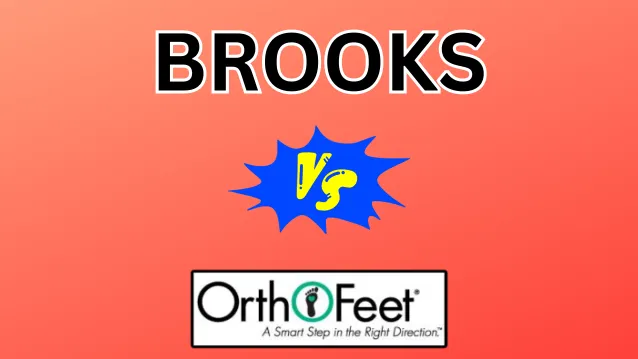When your feet hurt, every step feels miserable. Finding shoes with just the right support and comfort is crucial for anyone suffering from foot pain issues.
Two popular brands, Brooks and Orthofeet, both promise sweet relief for your sore soles. I compared these companies to help fellow foot pain friends discover if Brooks or Orthofeet will have you walking on clouds.
Comparison Table Between Brooks And Orthofeet:
| Category | Brooks | Orthofeet |
|---|---|---|
| Founded | 1914 | 1984 |
| Comfort | Adapts to all runners | Maximum cushioning |
| Colors | Lots of options! | More basics |
| Durability | Quite durable | Holds up well |
| Performance | Made for athletes | Not for sports |
| Style | Sleek, modern | Simple, practical |
| Popularity | Well-known by runners | More niche following |
| Top Seller | Adrenaline GTS | Orthofeet 611 Monterey Bay |
Brooks Overview
Brooks running shoes originated in 1914 in Seattle, Washington when the Brooks Shoe Company was founded. Though it started as a specialty shoe brand, Brooks eventually pivoted to focus on athletic and performance footwear in the 1970s.
Some of the long-running iconic features of Brooks shoes include:
- BioMoGo DNA: An adaptive midsole foam that provides soft landings followed by firm toe-offs for propulsion.
- GuideRails: An engineered support system around the midsole to limit excess pronation or inward foot rolling.
- Flextra: Outsole rubber strategically placed for flexibility where the foot needs to move.
- Ideal Pressure Zones: Designated cushioned zones on the outsole positioned under important areas.
- Adjustable saddle: A structured component that customizes midfoot support and fit.
- HydroFlow: Shock-absorbing cushioning units in the midsole for plush softness.
In addition to catering to regular neutral runners, Brooks offers stability, trail, walking, and casual shoes. Some of their most popular models through the years include the Ghost, Adrenaline GTS, Glycerin, and Ravenna.
With over 100 years of experience, Brooks uses proven technologies and innovations to create high-performance shoes suited for runners of all types.
Orthofeet Overview:
Orthofeet was founded in 1984 by two brothers Ron and Michael Bar who teamed up to create orthotic shoes to relieve foot pain.
Their shoes are specially designed with features like extra depth, spacious toe boxes, and multi-layered removable insoles to alleviate pain from conditions like bunions, plantar fasciitis, and diabetes.
Orthofeet uses premium orthotic materials and construction for stability and support.
Their shoes also utilize seam-free linings, cushioning at pressure points, and durable padding to protect sensitive feet.
While Orthofeet offers sandals and athletic shoes, their hallmark is making comfortable walking shoes that feel like slippers. Their shoes have a classic athletic style with minimal branding and come in widths from medium to extra wide.
Orthofeet is still family-owned and provides a 60-day wear guarantee so you can ensure their shoes provide pain relief.
Major Differences Between the Brands:
1) Comfort and Fit
Both brands clearly make comfort a high priority in their shoes. However, Brooks leans more into adaptive fits suited for athletes in motion, while Orthofeet focuses specifically on cushioning tender feet needing specialized pain relief.
Brooks shoes hug your feet like a glove, conforming around each curve while wicking away moisture. I like how they accommodate a spectrum of runner foot types – neutral, pronation, high arch, etc. The adjustable lacing systems give you that locked-in feeling.
Meanwhile, Orthofeet goes for plush, pillow-like padding maximizing stability and joint cushion for fragile feet. There’s extra room for bandages, hammer toes, and swollen areas needing to breathe. Rather than performance responsiveness, it’s about supple materials gently enveloping your sore soles like a spa treatment!
2) Durability and Performance
When it comes to ruggedness and performance capabilities, these brands have diverging priorities reflecting their target consumers. Brooks shoes need to stand up to heavy running mileage and endure all types of terrain from trails to pavement. Their…
3) Pricing
You’ll typically be spending around the same amount – $100 to $150 per pair – for both Brooks and Orthofeet shoes. However, the pricing reflects the different materials, functions and technologies being offered…
4) Style
If stylish looks play a big role in your shoe priorities, Brooks likely offers more options you’ll enjoy compared to the more straightforward designs of Orthofeet…
5) Popularity
It’s no contest that Brooks dominates here, being a household name among serious runners for generations. Orthofeet has carved out a nice niche catering to specialized orthopedic markets, but their shoes just don’t have that big mainstream appeal…
6) Target Markets
Stemming from their distinct product strengths and capabilities, Brooks and Orthofeet tailor their shoes towards very different target markets…
Final Verdict
At the end of the day, choosing between these brands comes down to your own feet’s needs. Brooks can’t be beat if you’re logging major miles running or training for athletic performance. Expect those shoes to mirror and support your active lifestyle with both tech-packed features and sporty style.
However, if you struggle with chronic foot pain issues or discomfort walking all day, I encourage you to try Orthofeet’s ultra-cushioned approach focused specifically on relief and stability. While not the flashiest, they get the job done helping you get back on your feet minus the ache!
I hope this breakdown gives you the confidence to take a step towards happier, pain-free feet. Now tie up some Brooks or Orthofeet kicks and enjoy that walk, run or hike without the suffering! Our soles deserve to smile too.

